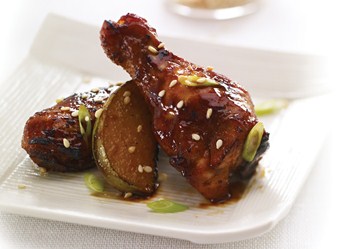
The McCormick® Flavor Forecast® for 2012 reveals that food lovers everywhere have much in common.
A global leader in flavor, McCormick & Company, Incorporated, is taking its Flavor Forecast® to the next level in 2012. For this milestone report, an international group of McCormick experts—including chefs, sensory scientists, trend trackers, marketing experts and food technologists—collaborated to identify global trends that will continue to shape the future of flavor.
After a year-long process of culinary exploration, data discovery and insight development, McCormick’s 2012 Flavor Forecast revealed a surprising finding: Food lovers around the world have more in common than expected. The trends impacting our food choices are strikingly similar from region to region, even though the specific foods, flavors and ingredients we enjoy are uniquely rooted in our local cultures.
The six globally relevant trends are brought to life through 12 regional flavor combinations:
Honoring Roots
Chefs inspired by foundational flavors are finding a way to balance modern flair with cultural authenticity.
1. Cumin with Sofrito (authentic Hispanic foundational flavors)
2. Korean Pepper Paste with Sesame, Asian Pear & Garlic (barbecue with a global twist)
Quest for the Ultimate
Flavor fanatics searching for the ultimate taste experience through quality ingredients, flavors and textures.
3. Dill with Mint, Melon & Cucumber (the ultimate refresher)
4. Meyer Lemon with Lemon Thyme, Limoncello & Lemon Peel (the ultimate lemon)
Veggies in Vogue
Fresh, seasonal veggies are dressed to impress with new cooking techniques and inventive bursts of flavor.
5. Eggplant with Honey & Harissa (worldly veggie with sweet heat)
6. Squash with Red Curry & Pancetta (versatile veggie with a touch of Thai)
Simplicity Shines
Clear, unpretentious flavors are an approachable celebration of the basics. A move away from complexity and flash.
7. Ginger with Coconut (warm spice joins tropical favorite)
8. Vanilla with Butter (pure essentials for real goodness)
Flavorful Swaps
Balancing bold flavor with hunger for health is key to achieving wellness goals, without sacrificing enjoyment.
9. Red Tea with Cinnamon & Plum (better-for-you beverage meets fruit and spice)
10. Grapefruit with Red Pepper (a new take on lemon pepper)
No Boundaries
Blending inspirations and shedding the confines of traditional “rules” equals a renewed permission to have fun.
11. Sweet Soy with Tamarind & Black Pepper (steak sauce with an Asian flair)
12. Blueberry with Cardamom & Corn Masa (from everyday to extraordinary)
“By taking a global view with the 2012 Flavor Forecast, our goal was to support the innovative chefs and foodservice professionals who are helping drive the growing demand for internationally influenced cuisines,” says Kevan Vetter, McCormick For Chefs® executive chef. “With their passion for food and our insight on flavor, the opportunities for menu innovation are endless.”
The McCormick Flavor Forecast has proven to be successful in serving as a catalyst for flavor innovation, playing an important part in moving edgy ingredients into mainstream popularity. Examples include:
- Chipotle. Highlighted in the 2003 Flavor Forecast, at that time, most weren’t aware of this chile pepper or even how to pronounce it. Today, chipotle can be found on menus everywhere, from fast-food outlets to upscale dining establishments. In fact, menu mentions of chipotle increased by 54% from 2004 to 2010.
- Cocktail-Inspired Meals. First identified in the 2008 Flavor Forecast, today, alcohol-inspired dishes, and even entire themed menus centered around a particular alcohol flavor, have grown in popularity in restaurants everywhere, with a recent emphasis on craft brews and bourbon.
“Staying on top of trends is essential to the culinary industry, as it gives us a clear pulse on how today’s culture is impacting food choices,” says Michael Ty, CEC, AAC, president of the American Culinary Federation. “McCormick has proven time and again to be a leading trend-information resource. We especially look forward to seeing their Flavor Forecast, which pushes the boundaries of what is possible with food and gives us a flavor roadmap for the future.”
To explore the future of flavor with inspired recipes, photos and video, visit www.McCormickForChefs.com/FlavorForecast.
Photo: In Korean barbecue, powerful ingredients combine in an intricate harmony for the senses. (See “Honoring Roots” above.) Gaining popularity as a result of interest in global street food and regional live-fire specialties, chefs are celebrating the balance inherent in this tasty heritage—dazzling the taste buds with a unique combination of sweet, sour, savory and bitter.
 This year will bring positive, long-lasting traffic trends to the industry, predicts NPD Group.
This year will bring positive, long-lasting traffic trends to the industry, predicts NPD Group.

 The low-fat approach to eating hasn’t reduced obesity or made people healthier, says the Harvard School of Public Health.
The low-fat approach to eating hasn’t reduced obesity or made people healthier, says the Harvard School of Public Health.
 Since 1971, Lettuce Entertain You Enterprises, Inc., has created high-quality, successful restaurants. The company operates more than 80 establishments throughout the country. Wildfire (voted most-popular Chicago restaurant 2008 through 2010 by Zagat) has seven locations. The McLean, Va., venue is also bustling and can serve 1,000 customers per day. Having spent most of his career with the Lettuce Entertain You family, this kind of intense “kitchen heat” doesn’t intimidate Executive Chef Eddie Ishaq. He says, “Let’s go!”
Since 1971, Lettuce Entertain You Enterprises, Inc., has created high-quality, successful restaurants. The company operates more than 80 establishments throughout the country. Wildfire (voted most-popular Chicago restaurant 2008 through 2010 by Zagat) has seven locations. The McLean, Va., venue is also bustling and can serve 1,000 customers per day. Having spent most of his career with the Lettuce Entertain You family, this kind of intense “kitchen heat” doesn’t intimidate Executive Chef Eddie Ishaq. He says, “Let’s go!”